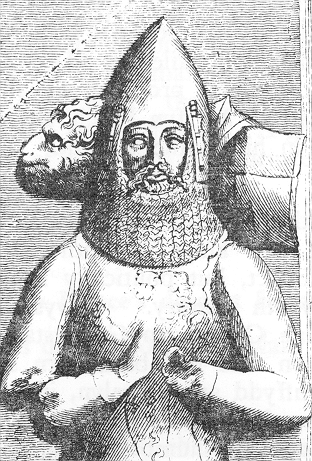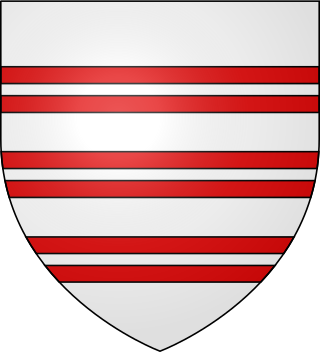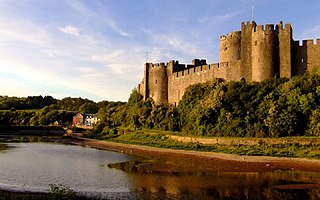
Rhys ap Gruffydd, commonly known as The Lord Rhys, in Welsh Yr Arglwydd Rhys was the ruler of the Welsh kingdom of Deheubarth in south Wales from 1155 to 1197 and native Prince of Wales.
Diarmait Mac Murchada, was King of Leinster in Ireland from 1127 to 1171. In 1167, he was deposed by the High King of Ireland, Ruaidrí Ua Conchobair. To recover his kingdom, Mac Murchada solicited help from King Henry II of England. His issue unresolved, he gained the military support of the Richard de Clare, 2nd Earl of Pembroke, thus initiating the Anglo-Norman invasion of Ireland.
Richard de Clare, 2nd Earl of Pembroke, Lord of Leinster, Justiciar of Ireland, also known as Richard FitzGilbert, was an Anglo-Norman nobleman notable for his leading role in the Anglo-Norman invasion of Ireland. Like his father, Richard FitzGilbert has since become commonly known by his nickname Strongbow.
Nest ferch Rhys was the daughter of Rhys ap Tewdwr, last King of Deheubarth in Wales, by his wife, Gwladys ferch Rhiwallon ap Cynfyn of Powys. Her family is of the House of Dinefwr. Nest was the wife of Gerald de Windsor, Constable of Pembroke Castle and son of the Constable of Windsor Castle in Berkshire, by whom she was the ancestress of the FitzGerald dynasty.

RaymondFitz William Fitz Gerald, nicknamed Le Gros, was a Cambro-Norman commander during the Norman invasion of Ireland. Raymond was among the first of a small band of Norman knights who landed on the South coast of Ireland before being reinforced by a larger force led by Richard de Clare, 2nd Earl of Pembroke. He was active consolidating Norman rule over Ireland before he retired to his estates in Waterford where he died in the late 12th century.

The history of Ireland from 1169–1536 covers the period from the arrival of the Cambro-Normans to the reign of Henry VIII of England, who made himself King of Ireland. After the Norman invasion of 1169–1171, Ireland was under an alternating level of control from Norman lords and the King of England. Previously, Ireland had seen intermittent warfare between provincial kingdoms over the position of High King. This situation was transformed by intervention in these conflicts by Norman mercenaries and later the English crown. After their successful conquest of England, the Normans turned their attention to Ireland. Ireland was made a lordship of the King of England and much of its land was seized by Norman barons. With time, Hiberno-Norman rule shrank to a territory known as the Pale, stretching from Dublin to Dundalk. The Hiberno-Norman lords elsewhere in the country became Gaelicised and integrated in Gaelic society.

The Anglo-Norman invasion of Ireland took place during the late 12th century, when Anglo-Normans gradually conquered and acquired large swathes of land from the Irish, over which the kings of England then claimed sovereignty, all allegedly sanctioned by the Papal bull Laudabiliter. At the time, Gaelic Ireland was made up of several kingdoms, with a High King claiming lordship over most of the other kings. The Norman invasion was a watershed in Ireland's history, marking the beginning of more than 800 years of direct English and, later, British, involvement in Ireland.

The de Barry family is a noble family of Cambro-Norman origins which held extensive land holdings in Wales and Ireland. The founder of the family was a Norman Knight, Odo, who assisted in the Norman Conquest of England during the 11th century. As a reward for his military services, Odo was granted estates in Pembrokeshire and around Barry, Wales, including Barry Island just off the coast.

Gerald de Windsor, aliasGerald FitzWalter, was an Anglo-Norman lord who was the first Castellan of Pembroke Castle in Pembrokeshire. Son of the first Constable of Windsor Castle, and married to a Welsh Princess, he was in charge of the Norman forces in south-west Wales. He was also steward and governor for the Norman magnate Arnulf de Montgomery. His descendants were the FitzGerald dynasty, as well as the FitzMaurice, De Barry, and Keating dynasties of Ireland, who were elevated to the Peerage of Ireland in the 14th century. He was also the ancestor of the prominent Carew family, of Moulsford in Berkshire, the owners of Carew Castle in Pembrokeshire and of Mohuns Ottery in Devon.
Events from the year 1169 in Ireland.
Events from the year 1171 in Ireland.

Maurice FitzGerald, Lord of Maynooth, Naas, and Llanstephan (born: almost certainly not at Windsor Castle, more likely Carew in Wales c.1105 – September c.1176 Wexford, Ireland. He was a medieval Anglo-Norman baron and a major figure in the Norman Invasion of Ireland.
Maurice de Prendergast was a Norman knight, fl. 1169–1174.

Gerald FitzMaurice, jure uxoris 1st Lord of Offaly was a Cambro-Norman nobleman who took part with his father, Maurice FitzGerald, Lord of Llanstephan, in the Norman Invasion of Ireland (1169–71). Together with his five brothers and one sister Nesta they founded the notable FitzGerald/FitzMaurice dynasty which was to play an important role in Irish history.
Barrymore is a barony in County Cork in Ireland. It is the namesake of the Norman de Barry family, latterly created Earls of Barrymore. Barrymore is bordered by eight baronies:
Meiler FitzHenry was a Cambro-Norman nobleman and Lord Chief Justice of Ireland during the Lordship of Ireland.

The siege of Wexford took place in early May 1169 and was the first major clash of the Norman invasion of Ireland. The town was besieged by a combined force of Normans under Robert Fitz-Stephen and soldiers loyal to Diarmait mac Murchadha. After being ousted as King of Leinster, Diarmait had recruited the Normans to help him regain control of Leinster and the semi-independent Norse-Gaelic seaport of Wexford. Although the attackers did not breach the town's walls, Wexford surrendered after almost two days and came under Norman control.
Robert de Barry was a Cambro-Norman warrior from Manorbier in Pembrokeshire who participated in the colonisation of the Kingdom of Desmond following the Norman invasion of Ireland.
Philip de Barry, was a Cambro-Norman warrior from Manorbier in Pembrokeshire who participated in the colonisation of Kingdom of Desmond following the Norman invasion of Ireland. He was the founder of the Barry or De Barry family in County Cork, and common ancestor of the barons Barry and earls of Barrymore.
Muskerry East is one of the baronies of Ireland, an historical geographical unit of land. Its chief town is Ballincollig. It is one of 24 baronies in the county of Cork. It may also be viewed as a half barony because some time before the 1821 census data, it was divided from its other half - Muskerry West. Other neighbouring baronies include Cork to the east, Duhallow to the north and the barony of Barretts to the north-east.










